Micro Quadcopters Toys Comparison
By the way, you can find the latest micro/mini quadcopters here
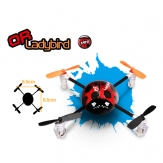 Walkera QR Ladybird V1, ~$60+, 12cm motor-to-motor center diameter, gyro/accelerometer, arms are 3mm X 3mm CF,
full size good feel and responsiveness using a DEVO 2402d Tx. Excellent
stability and flight performance. The Ladybird so far is the only micro
with a built in firmware upgrade capability. There is a POTI on the
flight controller to allow fine-tuning of the gyro performance. There is
an undocumented expo setting using the 2402d Tx by setting the AUX2 ON.
There are no adjustable rates on the DEVO 2402d Tx which is a full size
Tx unlike the other commonly supplied smaller and less precise DEVO 4
Tx. Telemetry info is available from the Ladybird FCB when using the
DEVO 7e, 10 and 8 and 12 "s" series of Walkera Tx's, however if
telemetry is used expect 1-2 minutes less flight time. The less
expensive Ladybird V2
does not have an accelerometer or telemetry. Both versions have a yaw
rate that is somewhat limited, but adequate for all but those who like
to fly extremely tight turns. You can add some rate and expo with the
better DEVO 6 and higher Tx's to compensate for this, if you want to
upgrade the Tx. There is an MTC-01 Tx adapter available that will work
on Android phones and tablets and allow some older Wakera non-Devo Tx's
to be used. There is also a MTC-01 hack by LittleMo
that allows it to work on the Turnigy 9x trainer port, so potentially
other hobby grade Tx's will work with it too. Weight: 25g minus lipo.
Walkera QR Ladybird V1, ~$60+, 12cm motor-to-motor center diameter, gyro/accelerometer, arms are 3mm X 3mm CF,
full size good feel and responsiveness using a DEVO 2402d Tx. Excellent
stability and flight performance. The Ladybird so far is the only micro
with a built in firmware upgrade capability. There is a POTI on the
flight controller to allow fine-tuning of the gyro performance. There is
an undocumented expo setting using the 2402d Tx by setting the AUX2 ON.
There are no adjustable rates on the DEVO 2402d Tx which is a full size
Tx unlike the other commonly supplied smaller and less precise DEVO 4
Tx. Telemetry info is available from the Ladybird FCB when using the
DEVO 7e, 10 and 8 and 12 "s" series of Walkera Tx's, however if
telemetry is used expect 1-2 minutes less flight time. The less
expensive Ladybird V2
does not have an accelerometer or telemetry. Both versions have a yaw
rate that is somewhat limited, but adequate for all but those who like
to fly extremely tight turns. You can add some rate and expo with the
better DEVO 6 and higher Tx's to compensate for this, if you want to
upgrade the Tx. There is an MTC-01 Tx adapter available that will work
on Android phones and tablets and allow some older Wakera non-Devo Tx's
to be used. There is also a MTC-01 hack by LittleMo
that allows it to work on the Turnigy 9x trainer port, so potentially
other hobby grade Tx's will work with it too. Weight: 25g minus lipo.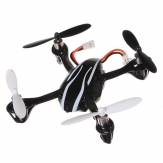 Hubsan X4 H107, ~$35+, 9cm motor-to-motor center diameter, gyro/accelerometer, monocoque plastic 2-piece body.
The frame can sustain cracks in collisions with hard objects or hard
ground. Sometimes it can be fixed with a bit of CA. The 2-piece body can
be replaced for about $5. If you are going to attempt this relatively
simple 15 minute job, you must be able to carefully solder the wires to
the board. The Tx has a nice feel and responsiveness, Normal and expert
adjustable rate modes, coded stick flips, ability to calibrate the accelerometer level.
Excellent stability and flight performance. This is the only one that
did not come with a set of extra props. The smallest of the micros at
9cm/3.75in motor to motor diameter. A very close second in flight
performance to the Ladybird V1. Performance outside in wind is
excellent. The supplied Tx(fake antenna), although better precision than
the others in the list below, is the only con. The plus for the Tx is
that it gives you the ability to adjust the stick sensitivity rates in
the normal(beginner) and expert modes to your personal desires. It also
has a feature to calibrate the sticks.
It would be a real plus for this micro to have the ability to bind with
better Tx's, perhaps by using something like the Anylink system. PhracturedBlue has posted a firmware and hardware mod to the better Walkera Tx's that will work with the Hubsan X4.
Hubsan X4 H107, ~$35+, 9cm motor-to-motor center diameter, gyro/accelerometer, monocoque plastic 2-piece body.
The frame can sustain cracks in collisions with hard objects or hard
ground. Sometimes it can be fixed with a bit of CA. The 2-piece body can
be replaced for about $5. If you are going to attempt this relatively
simple 15 minute job, you must be able to carefully solder the wires to
the board. The Tx has a nice feel and responsiveness, Normal and expert
adjustable rate modes, coded stick flips, ability to calibrate the accelerometer level.
Excellent stability and flight performance. This is the only one that
did not come with a set of extra props. The smallest of the micros at
9cm/3.75in motor to motor diameter. A very close second in flight
performance to the Ladybird V1. Performance outside in wind is
excellent. The supplied Tx(fake antenna), although better precision than
the others in the list below, is the only con. The plus for the Tx is
that it gives you the ability to adjust the stick sensitivity rates in
the normal(beginner) and expert modes to your personal desires. It also
has a feature to calibrate the sticks.
It would be a real plus for this micro to have the ability to bind with
better Tx's, perhaps by using something like the Anylink system. PhracturedBlue has posted a firmware and hardware mod to the better Walkera Tx's that will work with the Hubsan X4. 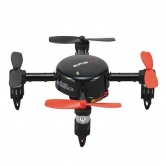 RC Eye One,
~70+, Although this quad is micro-sized at 12cm diameter
motor-to-motor, it uses slightly larger motors and a 2s lipo with a
proprietary connector and weighs about 3x as much as the other micros
that I have flown. Because of this it almost needs its own category
since the weight is almost 3x higher than equally sized and performing
micro sized multicopters. The more they weigh, the harder they fall
applies here. The props are 2.5in. It uses gyros and accelerometers. The
arms are 8mm aluminum and almost unbreakable. The center piece that
they attach to is plastic and can break in a hard crash where the arm is
attached. The OEM package includes an extra set of 4 props and the
motor bottom protectors(skids) and the USB lipo charger that is specific
for the proprietary lipo connecter. You can easily do several different
connector mods to utilize more common and cheaper lipos. There is a procedure to calibrate the accelerometer's
which is necessary for proper self-leveling performance. The RCE1 is a
very stable quad at its OEM AUW and has a very docile beginner mode that
will make it easy for Noobs to fly. The sport mode allows for more
angle input and higher speeds while still using self-leveling. Both
these modes limit throttle so when using them it will not be able to
lift much extra weight such as an about 17g 808 OEM keycam without
inducing a wobble of death(WOD). The Increased AUW of ~17g WOD can be
minimized somewhat by fitting either Walkera QR Ladybird or Mini Pet props.
The expert mode has more available throttle and better lift, but does
not self-level, so it requires more flying skill. It will maintain the
angle that was set and you will have to keep it in visual range to pilot
it back to level. None of the modes will allow the RCE1 to do a flip,
either automatically or manually. It is the only micro that is not
capable due to firmware coding to do a flip. These issues point to the
need for the capability to tune the RCE1 gyro responsiveness for higher
flying weights in all modes, but that capability does not yet exist. The
capability of a firmware upgrade has been mentioned as a future
feature, but does not yet exist. The Tx is a smallish game controller
type. It operates on 915Mhz vs. the more common 2.4ghz and uses a
proprietary protocol. It has two buttons on top that are non-functional.
It has ben mentioned that RC Logger is developing an add-on module like
the "Anylink" that will allow the RCE1 to be controlled by user's hobby
grade Tx's. The flight time with the OEM 2s lipo is 6-7 minutes which
is about the same as the lighter micros. The range is about 50M. When
the RCE1 loses the tx signal the motors will stop, but they will
re-start if it is a momentary condition. Weight is 58.7g minus the OEM
18.8g 2s lipo.
RC Eye One,
~70+, Although this quad is micro-sized at 12cm diameter
motor-to-motor, it uses slightly larger motors and a 2s lipo with a
proprietary connector and weighs about 3x as much as the other micros
that I have flown. Because of this it almost needs its own category
since the weight is almost 3x higher than equally sized and performing
micro sized multicopters. The more they weigh, the harder they fall
applies here. The props are 2.5in. It uses gyros and accelerometers. The
arms are 8mm aluminum and almost unbreakable. The center piece that
they attach to is plastic and can break in a hard crash where the arm is
attached. The OEM package includes an extra set of 4 props and the
motor bottom protectors(skids) and the USB lipo charger that is specific
for the proprietary lipo connecter. You can easily do several different
connector mods to utilize more common and cheaper lipos. There is a procedure to calibrate the accelerometer's
which is necessary for proper self-leveling performance. The RCE1 is a
very stable quad at its OEM AUW and has a very docile beginner mode that
will make it easy for Noobs to fly. The sport mode allows for more
angle input and higher speeds while still using self-leveling. Both
these modes limit throttle so when using them it will not be able to
lift much extra weight such as an about 17g 808 OEM keycam without
inducing a wobble of death(WOD). The Increased AUW of ~17g WOD can be
minimized somewhat by fitting either Walkera QR Ladybird or Mini Pet props.
The expert mode has more available throttle and better lift, but does
not self-level, so it requires more flying skill. It will maintain the
angle that was set and you will have to keep it in visual range to pilot
it back to level. None of the modes will allow the RCE1 to do a flip,
either automatically or manually. It is the only micro that is not
capable due to firmware coding to do a flip. These issues point to the
need for the capability to tune the RCE1 gyro responsiveness for higher
flying weights in all modes, but that capability does not yet exist. The
capability of a firmware upgrade has been mentioned as a future
feature, but does not yet exist. The Tx is a smallish game controller
type. It operates on 915Mhz vs. the more common 2.4ghz and uses a
proprietary protocol. It has two buttons on top that are non-functional.
It has ben mentioned that RC Logger is developing an add-on module like
the "Anylink" that will allow the RCE1 to be controlled by user's hobby
grade Tx's. The flight time with the OEM 2s lipo is 6-7 minutes which
is about the same as the lighter micros. The range is about 50M. When
the RCE1 loses the tx signal the motors will stop, but they will
re-start if it is a momentary condition. Weight is 58.7g minus the OEM
18.8g 2s lipo. MJX X100, ~$35+, 12cm motor-to-motor center diameter, gyro/accelerometer, 4.4mm X 4.4mm aluminum arms.
Frame has LEDs. Beginner and Pro selectable Tx rates, throttle
adjustment knob on the Tx can be used to fine-tune hover. Coded button
and stick flips in Pro mode. Note: The Mini Pet and X100 have the
same Tx/Rx protocol and will bind with each others Tx's. The flight
control boards appear to be identical, and the arms, motors and props
are interchangeable. The flight performance is about the same when
using the same Tx. They both perform the best with the MJX Tx. Weight:
29.2g minus lipo.
MJX X100, ~$35+, 12cm motor-to-motor center diameter, gyro/accelerometer, 4.4mm X 4.4mm aluminum arms.
Frame has LEDs. Beginner and Pro selectable Tx rates, throttle
adjustment knob on the Tx can be used to fine-tune hover. Coded button
and stick flips in Pro mode. Note: The Mini Pet and X100 have the
same Tx/Rx protocol and will bind with each others Tx's. The flight
control boards appear to be identical, and the arms, motors and props
are interchangeable. The flight performance is about the same when
using the same Tx. They both perform the best with the MJX Tx. Weight:
29.2g minus lipo.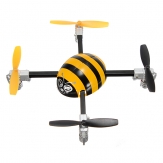 Mini Pet V997, ~$35+, 12cm motor-to-motor center diameter, gyro/accelerometer, 4.4mm X 4.4mm aluminum arms.
Frame has LEDs. Beginner and Pro selectable rates. Coded button and
stick flips in Pro mode. This one is one step below the X100 due to a
slightly more toyish Tx. Both the X100 and Mini Pet have slightly less
performance than the Hubsan X4 Ladybird QR V1 and no firmware upgrade
capability. Selectable Tx rates. Weight 28g minus lipo.
Mini Pet V997, ~$35+, 12cm motor-to-motor center diameter, gyro/accelerometer, 4.4mm X 4.4mm aluminum arms.
Frame has LEDs. Beginner and Pro selectable rates. Coded button and
stick flips in Pro mode. This one is one step below the X100 due to a
slightly more toyish Tx. Both the X100 and Mini Pet have slightly less
performance than the Hubsan X4 Ladybird QR V1 and no firmware upgrade
capability. Selectable Tx rates. Weight 28g minus lipo. Vitality H36, ~$35+, 12cm, motor-to-motor center diameter, gyro only, 3mm X 3mm CF arms, normal
and expert rates, Auto flip button. The Tx has the ability to change
Modes 1, 2 and 3 but the instructions do not describe the modes
correctly and the switch for Mode1 makes it mode 2. Can be bound with
FlySky/Turnigy/Eurgle Tx's. Weight: 26.3g minus lipo.
Vitality H36, ~$35+, 12cm, motor-to-motor center diameter, gyro only, 3mm X 3mm CF arms, normal
and expert rates, Auto flip button. The Tx has the ability to change
Modes 1, 2 and 3 but the instructions do not describe the modes
correctly and the switch for Mode1 makes it mode 2. Can be bound with
FlySky/Turnigy/Eurgle Tx's. Weight: 26.3g minus lipo.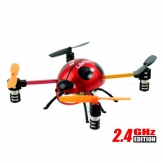 SH-6043, ~$35+, 13cm motor-to-motor center diameter, gyro and accelerometer (the ads inaccurately say 4-axis), 3mm X 3mm red and gold anodized aluminum arms, Tx
uses a proprietary protocol and is a game-pad shape and uses
non-standard trim buttons and orientation as side to side for yaw and
aileron and a rocker switch on the top right for the pitch, top left
rocker switch sets one slower rate mode and a higher rate flip mode. The
Tx can be set to modes 1, 2, 3 and 4. No English manual included but
one is posted here. Weight is 24.0g minus lipo, canopy weight is 1.4g.
SH-6043, ~$35+, 13cm motor-to-motor center diameter, gyro and accelerometer (the ads inaccurately say 4-axis), 3mm X 3mm red and gold anodized aluminum arms, Tx
uses a proprietary protocol and is a game-pad shape and uses
non-standard trim buttons and orientation as side to side for yaw and
aileron and a rocker switch on the top right for the pitch, top left
rocker switch sets one slower rate mode and a higher rate flip mode. The
Tx can be set to modes 1, 2, 3 and 4. No English manual included but
one is posted here. Weight is 24.0g minus lipo, canopy weight is 1.4g.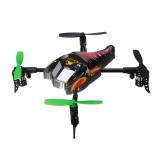 WLToys V202, ~$35+, 13cm motor-to-motor center diameter, gyro/accelerometer, 3mm X 4mm CF arms.(different
flight controller but same frame as V939 including LEDs and wire
connectors), Selectable Tx rates x5 on top left button. Auto flips with
full stick in any direction on 100% rates and produces very tight flips
when using a fully charged lipo. Top right Tx button turns LEDs on/off.
Most of these seem to require significant trim of 8-10 clicks back pitch
and 6-8 right aileron/roll to keep from rapidly drifting off and to
make it takeoff straight up. The yaw response is the slowest of the
micros here on my list. There is also a glitch in the code that shows up
as an occasional drop in the left front motor/arm when you are hovering. Proprietary Tx/Rx protocol with familiar WLToys Tx. Weight: 30.9g with relatively heavy 2.3g "scorpion" canopy minus lipo.
WLToys V202, ~$35+, 13cm motor-to-motor center diameter, gyro/accelerometer, 3mm X 4mm CF arms.(different
flight controller but same frame as V939 including LEDs and wire
connectors), Selectable Tx rates x5 on top left button. Auto flips with
full stick in any direction on 100% rates and produces very tight flips
when using a fully charged lipo. Top right Tx button turns LEDs on/off.
Most of these seem to require significant trim of 8-10 clicks back pitch
and 6-8 right aileron/roll to keep from rapidly drifting off and to
make it takeoff straight up. The yaw response is the slowest of the
micros here on my list. There is also a glitch in the code that shows up
as an occasional drop in the left front motor/arm when you are hovering. Proprietary Tx/Rx protocol with familiar WLToys Tx. Weight: 30.9g with relatively heavy 2.3g "scorpion" canopy minus lipo. WLToys V939, ~$35+, 13cm motor-to-motor center diameter, gyro only, 3mm X 4mm CF arms. Frame has LEDs. Selectable Tx rates. Auto flip button. Can be bound with FlySky/Turnigy/Eurgle Tx's. Weight: 31g minus lipo
WLToys V939, ~$35+, 13cm motor-to-motor center diameter, gyro only, 3mm X 4mm CF arms. Frame has LEDs. Selectable Tx rates. Auto flip button. Can be bound with FlySky/Turnigy/Eurgle Tx's. Weight: 31g minus lipo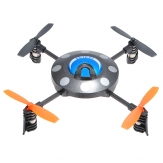 UDI U816, ~$35+, 12cm motor-to-motor center diameter, gyro/accelerometer, 3mm X 3mm. CF arms.
The throttle control makes this one more difficult to maintain an
altitude in hover and requires more finesse control on the sticks.
Selectable Tx rates. The Tx uses a proprietary protocol. Weight: 25.9g
minus lipo.
UDI U816, ~$35+, 12cm motor-to-motor center diameter, gyro/accelerometer, 3mm X 3mm. CF arms.
The throttle control makes this one more difficult to maintain an
altitude in hover and requires more finesse control on the sticks.
Selectable Tx rates. The Tx uses a proprietary protocol. Weight: 25.9g
minus lipo.